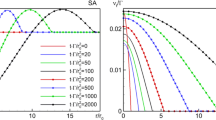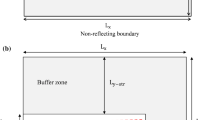Abstract
Prompted by the lack of a unique choice of pressure (P) and density (ρ) fields for a compressible free vortex and by the observed dependence of turbulence dynamics on initial P and ρ in compressible simulations, we address the effects of initial conditions on the evolution of a single vortex, on the prototypical phenomenon of vortex reconnection, and on two-dimensional turbulence. Two previous choices of initial conditions used for numerical simulations of compressible turbulence have been: (i) both P and ρ uniform (constant initial conditions, CIC), and (ii) uniform ρ with P determined from the Poisson equation (constant density initial conditions, CDIC). We find these initial conditions to be inappropriate for compressible vorticity dynamics studies. Specifically, in compressible reconnection, the effects of baroclinic vorticity generation and shocklet formation cancel each other during early evolution for CDIC, thus leading to almost incompressible behavior. Although CIC captures compressibility effects, it incorrectly changes the initial vorticity distribution by introducing strong acoustic transients, thereby significantly altering the evolving dynamics.
Here, a new initial condition, called polytropic initial condition (PIC), is proposed, for which the Poisson equation is solved for initially polytropically related P and ρ fields. PIC provides P and ρ distributions within vortices which are consistent with those observed in shock-wedge interaction experiment and also leads to compressible solutions with no acoustic transients. At low Mach number (M), we show that the effects of all these three initial conditions can be predicted by low-M asymptotic theories of the Navier-Stokes equations. At high M, it is shown here that inappropriate initial conditions may alter the evolutionary dynamics and, hence, lead to wrong conclusions regarding compressibility effects. We argue that PIC is a more appropriate choice.
Similar content being viewed by others
References
Ashurst, W.T., and Meiron, D.I. (1987). Numerical study of vortex reconnection. Phys. Rev. Lett., 58, 1632–1635.
Broadbent, E.G., and Moore, D.W. (1979). Acoustic destabilization of vortices. Philos. Trans. Roy. Soc. London Ser. A, 290, 353–371.
Broadbent, E.G. (1984). Stability of a compressible two-dimensional vortex under a three-dimensional perturbation. Proc. Roy. Soc. London Ser. A, 392, 279–299.
Buntine, J.D., and Pullin, D.I. (1989). Merger and cancellation of strained vortices. J. Fluid Mech., 205, 263–295.
Chu, B.-T., and Kovasznay, L.S.G. (1958). Nonlinear interactions in a viscous heat-conducting compressible gas. J. Fluid Mech., 3, 494–514.
Colonius, T., Lele, S.K., and Moin, P. (1991). The free compressible viscous vortex. J. Fluid Mech., 230, 45–73.
Dosanjh, D.S., and Weeks, T.M. (1965). Interaction of a starting vortex as well as a vortex street with a traveling shock wave. AIAA J., 3, 216–223.
Erlebacher, G., Hussaini, M., Kreiss, H., and Sarkar, S., (1990). The Analysis and Simulation of Compressible Turbulence. ICASE Report No. 90–15.
Feiereisen, W., Reynolds, W., and Ferziger, J. (1981). Numerical Simulation of a Compressible, Homogeneous, Turbulent Shear Flow. Report No. TF-13, Stanford University, Stanford, CA.
Howard, L.N., and Matthews, D.L. (1956). On the vortices produced in shock diffraction. J. Appl. Phys., 26(3), 223–231.
Hussain, F. (1986). Coherent structures and turbulence. J. Fluid Mech., 173, 303–356.
Hussain, F., Virk, D., and Melander, M.V. (1993). New studies in vortex dynamics: incompressible and compressible vortex reconnection, core dynamics, and coupling between large and small scales. Sādhanā, Proc. Indian Acad. Sci. Parts 3 & 4, 18 (in press).
Kerr, R., and Hussain, F. (1987). Simulation of vortex reconnection. Phys. D, 37, 474–484.
Kerr, R., Virk, D., and Hussain, F. (1989). Effects of incompressible and compressible vortex reconnection. In Topological Fluid Mechanics (eds. Moffatt, H., and Tsinober, A.), pp. 500–514. Cambridge University Press, Cambridge.
Kida, S., Takoaka, M., and Hussain, F. (1991a). Collision of two vortex rings. J. Fluid Mech., 230, 583–646.
Kida, S., Takoaka, M., and Hussain, F. (1991b). Formation of head-tail structure in two-dimensional straining flow. Phys. Fluids A, 3(11), 2688–2697.
Kovasznay, L.S.G. (1953). Turbulence in supersonic flow. J. Aero. Sci., 20(10), 657–674.
Lee, S., Lele, S., and Moin, P. (1991). Eddy shocklets in decaying compressible turbulence. Phys. Fluids A, 3(4), 657–664.
Mack, L.M. (1960). The compressible viscous heat-conducting vortex. J. Fluid Mech., 8, 284–292.
Mandella, M.J. (1987). Experimental and Analytical Studies of Compressible Vortices. Ph.D. thesis, Stanford University, Stanford, CA.
McKenzie, J., and Westphal, K. (1968). Interaction of linear waves with oblique shocks. Phys. Fluids, 11(11), 2350–2362.
Melander, M., and Hussain, F. (1988). Cut-and-Connect of Two Antiparallel Vortex Tubes. CTR Report S-88, NASA Ames, pp. 257–286.
Melander, M., and Hussain, F. (1989). Cross-linking of two antiparallel vortex tubes. Phys. Fluids A, 1(4), 633–636.
Passot, T., and Pouquet, A. (1987). Numerical simulation of compressible homogeneous flows in the turbulent regime. J. Fluid Mech., 181, 441–466.
Taylor, G.I. (1930). Recent work on the flow of compressible fluids. J. London Math. Soc., 5, 224–240.
Thompson, P.A. (1984). Compressible-Fluid Dynamics. McGraw-Hill, New York.
Virk, D. (1993). Numerical Studies of Vortex Dynamics: Compressible Reconnection and a Polarized Ring. Ph.D. thesis, University of Houston, Houston, TX.
Virk, D., and Hussain, F. (1991). Initial conditions for spectral simulations of compressible vortex interactions. Bull. Amer. Phys. Soc., 36(10), 2716.
Virk, D., Hussain, F., and Kerr, R. (1992). Numerical simulation of compressible vortex reconnection. Proc. 5th Asian Congress of Fluid Mechanics, Taejon, Korea, pp. 443–446.
Zank, G.P., and Matthaeus, W.H. (1991). The equations of nearly incompressible fluids. I. Hydrodynamics, turbulence, and waves. Phys. Fluids A, 3(1), 69–82.
Zeman, O. (1991). On the decay of compressible isotropic turbulence. Phys. Fluids A, 3(5), 951–955.
Author information
Authors and Affiliations
Additional information
Communicated by M.Y. Hussaini
D. Virk acknowledges financial support of the Advanced Study Program at NCAR, Boulder, for 2 years during graduate studies. Part of this work and the writing of the paper have been supported by NSF Grant CTS-9214818.
Rights and permissions
About this article
Cite this article
Virk, D., Hussain, F. Influence of initial conditions on compressible vorticity dynamics. Theoret. Comput. Fluid Dynamics 5, 309–334 (1993). https://doi.org/10.1007/BF00271425
Received:
Accepted:
Issue Date:
DOI: https://doi.org/10.1007/BF00271425




